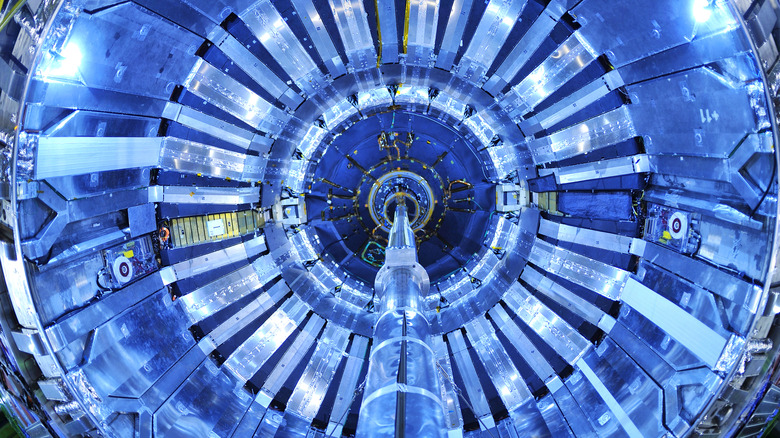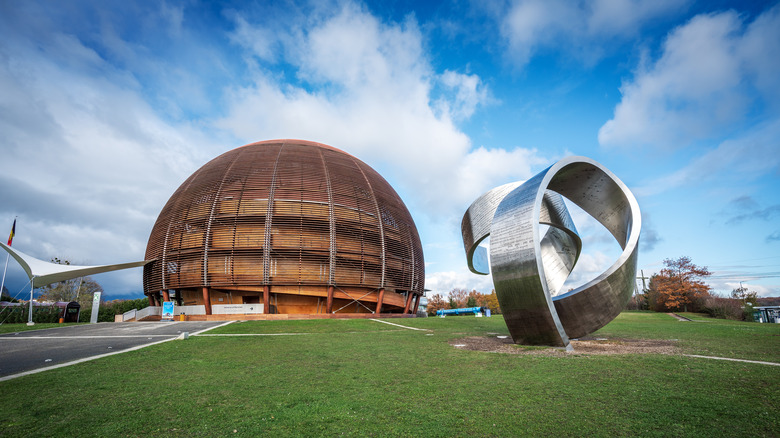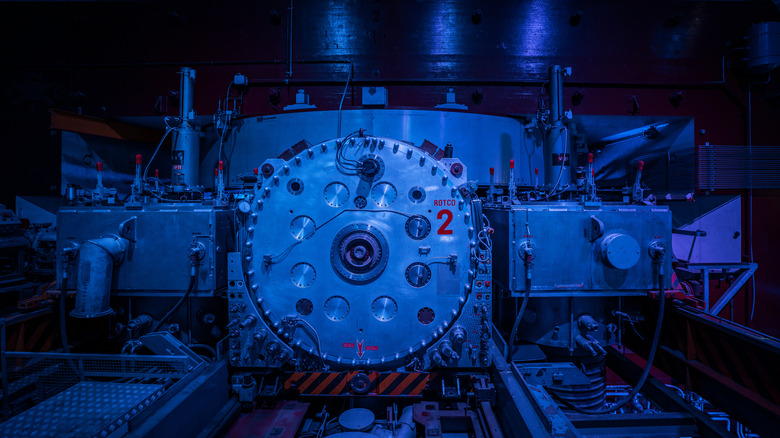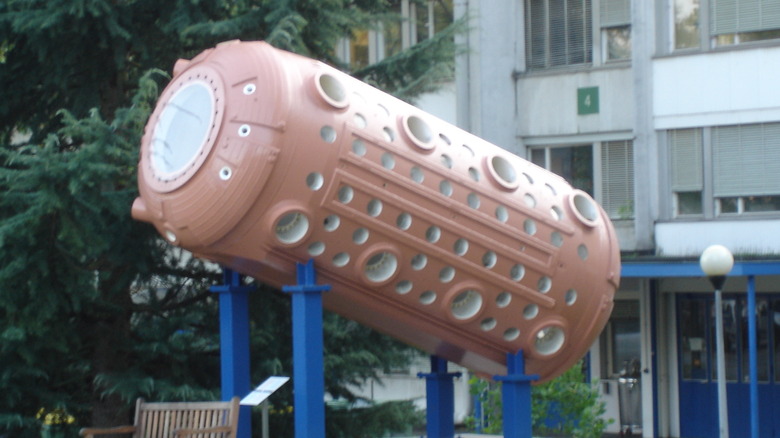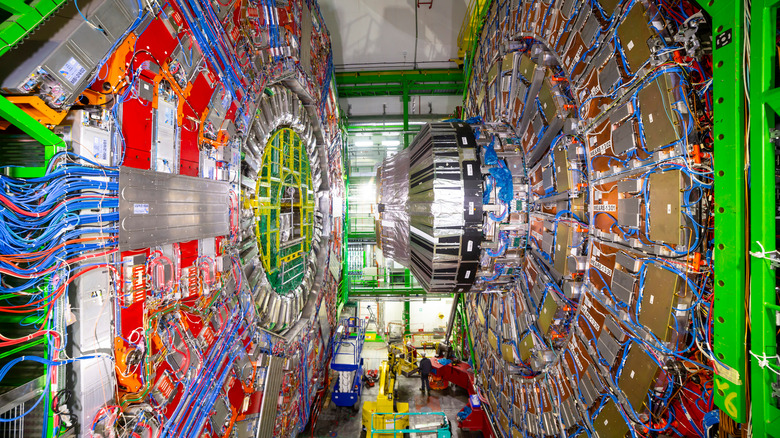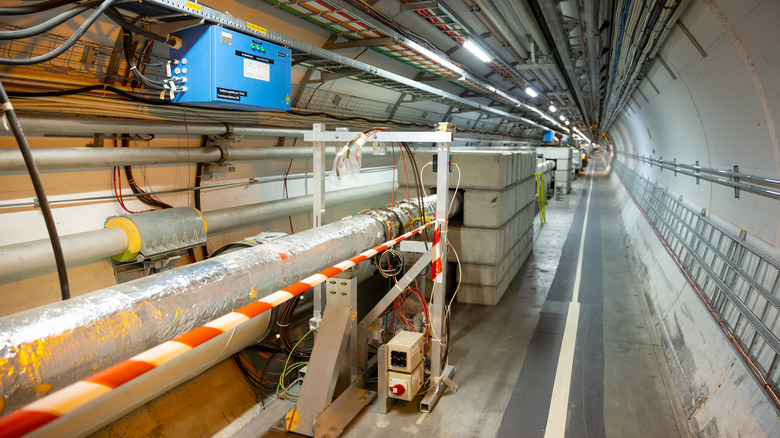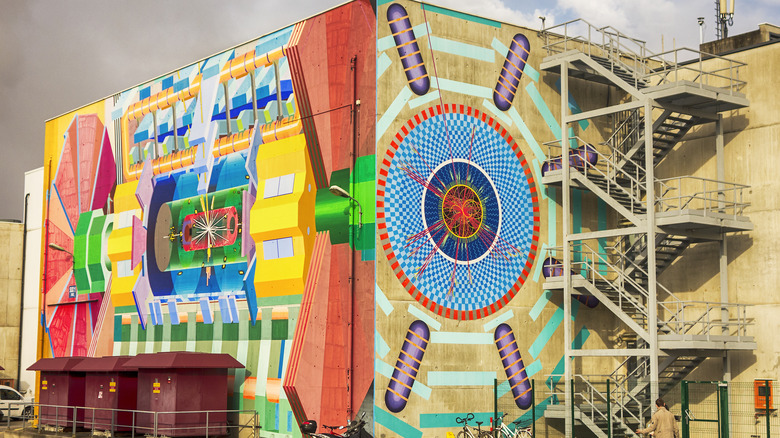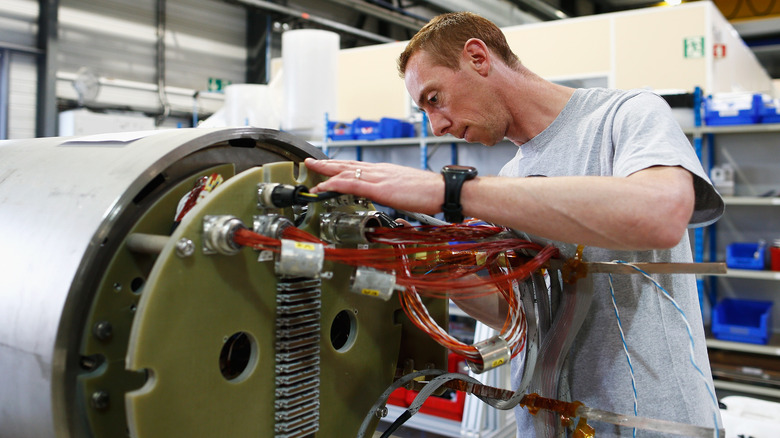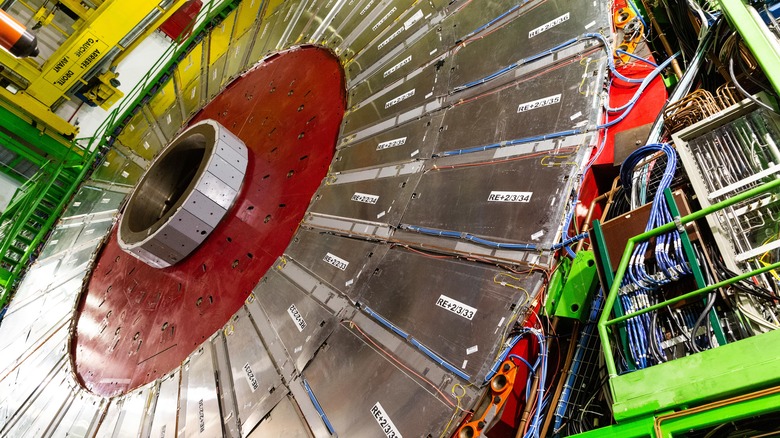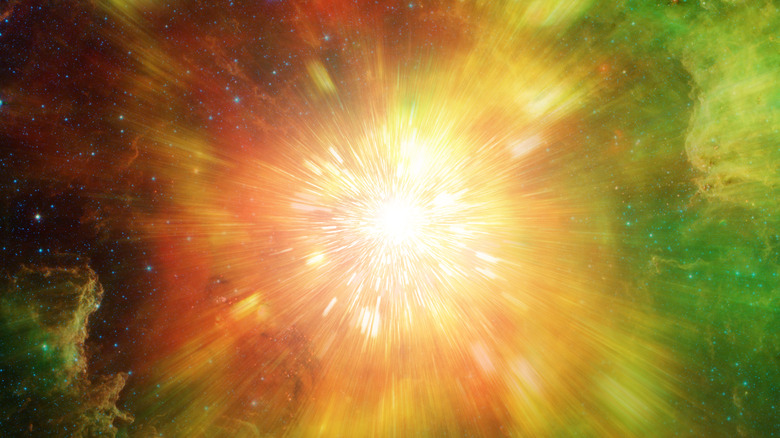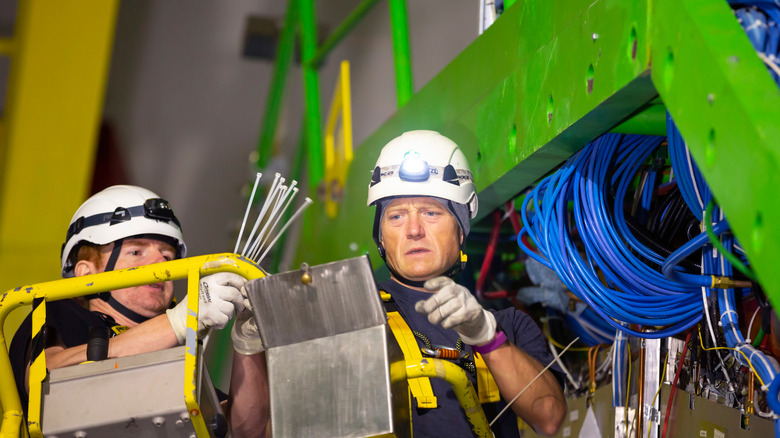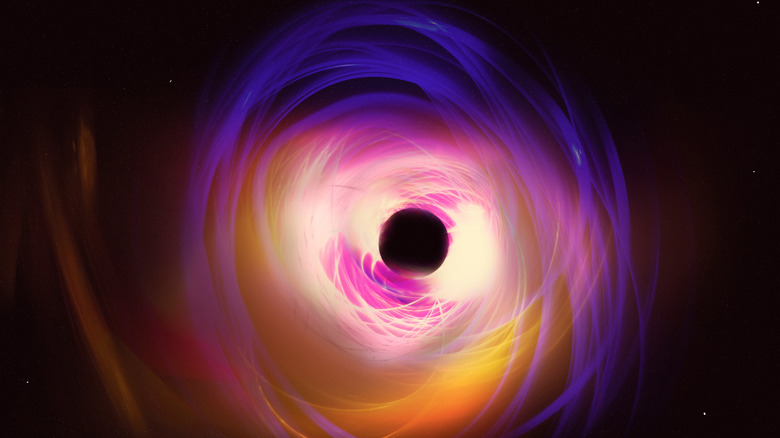The Untold Truth Of CERN
In J.R.R. Tolkien's "The Fellowship of the Ring," the wizard Gandalf says to the fallen wizard Saruman, "And he that breaks a thing to find out what it is has left the path of wisdom." The truth is that the science research organization CERN does just that. If you want to witness experiments that will make your head spin like a quark, then you should make your way over to Meyrin, Switzerland. This town, just outside Geneva and along the French border, is where CERN makes its home.
CERN is an international scientific organization whose purpose is to study the tiniest bits of what makes us, us –- fundamental particles such as quarks, the smallest things scientists know. The Guardian explains the size of a quark. A grain of sand is about a million times bigger than a DNA double helix, and a double helix is about 40 times bigger than a hydrogen atom. A hydrogen atom is about 60,000 times bigger than the radius of a proton. That is about 2,000 times bigger than a quark.
So how do you look for such small things? At CERN they use huge particle accelerators and detectors. The idea is that by using these complex pieces of equipment you can smash different particles at each other. Then, in the wreckage, you can see what bits come out and thereby increase the greater wisdom of humanity.
CERN is purely a research organization
CERN is an acronym, but it is outdated. Britannica tells us that the Organisation Européene pour la Recherche Nucléaire, translated to the European Organization for Nuclear Research, has operated CERN since 1954. Predating that, and where the acronym comes from, is Conseil Européen pour la Recherche Nucléaire, which originated in 1949 when European scientists in the wake of World War II wanted to restore scientific eminence to the continent and draw scientists back who had fled, as per the organization's website. CERN's convention clearly shows that it aspired to the highest of scientific ethics and openness. CERN was to conduct "... nuclear research of a pure scientific and fundamental character ..."
Furthermore, CERN is explicitly non-military. This last fact explains why neutral Switzerland was chosen as its location. In the effort to bolster collaboration, all of CERN's research findings were to be made available. And since the bulk of the work at CERN is based on fundamental particles, the actual site is often called the European Laboratory for Particle Physics.
Currently CERN consists of 23 member states (those who contribute the bulk of the funding) and 10 associate members. The United States is a non-member but holds what is called an observer status so that it can examine research performed in two of CERN's most celebrated pieces of equipment, the Large Hadron Collider (LHC) and the High Luminosity Large Hadron Collider (HL-LHC).
It started making immediate breakthroughs
As CERN notes, much of its research is conducted through particle accelerators and particle detectors. How these things work can be as confusing as the difference between a muon and a lepton, but thankfully Britannica provides an overview for the uninitiated. A particle accelerator works by generating a particle by electricity that can be an electron, proton, or ion. These are sent either in a straight or circular path using an electric field, which can either slow or speed them through repulsion or attraction. To keep them on a straight or curved path magnets are used. Physicists can either collide particles coming from opposite directions or hit a specific target. Once they collide, scientists can look at the leftover bits and analyze the radiation through a detector. The truth is if you want to see a particle accelerator, you don't have to go to Switzerland. An X-ray machine, such as the one you may experience at the dentist, is an example of a linear particle accelerator.
CERN's first particle accelerator, the 600-MeV Synchrocyclotron (SC), was first activated in 1957. Scientists wanted to study the decay of rare pion particles based on a working theory that they should decay into neutrinos and electrons. This was proved only hours after the experiment was first conducted in 1958. Aside from the discovery, the SC experiment showed that international scientific collaboration could work.
The Gargamelle Bubble Chamber didn't involve smurfs
According to CERN, one of its key experiments concerns the Gargamelle Bubble Chamber. The truth is that this chamber had nothing to do with a balding warlock hunting diminutive blue creatures for dinner. Gargamelle was named after the mother of the giant Gargantua from a story by François Rabelais. The chamber, measuring over 13-feet long and 6-feet wide, contained some 18 tons of freon. Its purpose was to detect neutrinos. These particles, Britannica explains, have no charge and cannot leave evidence of themselves in the chamber. Rather, the chamber was used to indirectly show the presence of neutrinos by showing how it impacted charged particles.
The experiments, which were conducted in the 1970s, helped to provide evidence of quarks, which are the most basic unit of protons and neutrons. Results from the chamber supported separate research that provided evidence of the weak nuclear force that involves radioactive decay and is an essential element in nuclear fusion, as per Britannica. Further, CERN experiments found two particles, the W and Z particles, which carried this force that resulted in a Nobel prize in physics in 1984 for Carlo Rubbia and Simon Van der Meer.
CERN gave birth to the internet
One of the most practical innovations to come out of CERN is the internet. Britannica tells us that in 1980, the British computer scientist Tim Berners-Lee was serving as a computer consultant at CERN. During this time he developed software named Enquire that connected files through what became known as hypertexting. He left CERN that year but returned four years later to develop the means by which different computers could communicate with one another, as well as allow users to control computers remotely.
By 1989 he developed a way to enable this form of communication at a distance so scientists could share results. This formed the basis for the first web browser and web server. The World Wide Web, HTML, and linking were born. The truth is, however, that this beginning of the web was not quite as flashy as one might expect. The first practical application of the new technology was the CERN telephone directory.
It produces particles that could destroy anything
One often overlooked detail about CERN is that it can create particles that can potentially destroy anything in the universe. You see, CERN can create antimatter, as the organization explains. Antimatter is the same particles that you, your cat, or your morning cup of coffee are made of, but of an opposite charge. For every particle there must be an antiparticle. Now if you spilled some of your regular morning coffee into a cup of antiparticle coffee, they would annihilate each other in a tremendous flash of energy.
CERN goes out of the way to create antimatter using the Antiproton Decelerator. This machine works by shooting a beam of protons at metal, which produces antiprotons. It then uses a magnet to direct them while electrical fields slow them down so that they can form antimatter. It was in this way that antihydrogen atoms were created in 2002 but quickly were annihilated, and CERN succeeded in capturing some for 16 minutes in 2011.
Is this dangerous? Symmetry gives us some assurance. While a gram of antimatter may cause something akin to a nuclear explosion, the amounts of antimatter at play at CERN are so tiny at one nanogram that there is no reason to be alarmed. The truth is that if you took all the antimatter produced at CERN and every other similar facility around the globe and annihilated it, it could not boil a cup of water.
It has the world's largest particle accelerator
CERN's most famous piece of equipment is its Large Hadron Collider (LHC). Live Science provides some of the staggering details about the LHC. It is best described as a 16.5-mile ring tunnel that travels deep under the Alps in Switzerland and France. At this size, it is the world's largest particle collider, and Guinness World Records names the LHC as the largest machine in the world, period.
The genesis of the LHC began in 1977 when Sir John Adams, a former CERN director, suggested building the long tunnel so that particle testing could be done at very high energies. The project was approved in 1997, and the LHC was first used on September 10, 2008. Due to its size, CERN says the LHC is capable of accelerating protons to 99.9999991% the speed of light. To facilitate these mind bending speeds, scientists have created a vacuum within the accelerator for the particles as empty as the space between the planets. This prevents particles from bumping into unwanted gas molecules. It is in this way that beams of energy are shot in opposite directions and produce up to 600 million particle collisions every second. And in case you were wondering, a hadron is any subatomic particle.
The Large Hadron Collider is so hot that the Sun is like Antarctica in comparison
The scale of the CERN's colliders is extreme, and so is the energy it produces. In 2012, for example, Nature reported that scientists used the LHC to collide heavy lead ions. This created for a brief moment a quark-gluon plasma, which is theorized to have been present shortly after the Big Bang. This stuff is so hot that it was estimated to be 5.5 trillion degrees Fahrenheit. These types of heat levels, according to CERN, are about 100,000 times hotter than the core of the sun.
This heat can melt nearly anything, so what protects the LHC from its own success? Symmetry explains that aside from its elaborate cooling system, scientists can divert the two colliding beams using magnetism and direct them as they run out of energy into a 26-foot graphite cylinder encased in concrete. This apparently becomes hot, almost 1,300 Fahrenheit, but doesn't melt. Graphite has a melting point of some 6,500 degrees.
The Large Hadron Collider is also colder than deep space
As hot as the LHC can get, its magnets that guide the particle beams are required to get very cold. CERN explains that all the magnets are electromagnets, which operate by the flow of electrical current. Magnets that operate at extremely low temperature become superconductors, which means no power loss and little resistance. This helps prevent parts of the LHC from overheating. But this isn't Antartica cold. It's as cold as deep space at -456 degrees Fahrenheit (deep space clocks in at -455 degrees Fahrenheit, as per Astronomy). To get temperatures this low, the LHC uses liquid helium. But the truth is that this is a laborious process that takes weeks using liquid nitrogen and heat exchangers to slowly lower the temperature of the helium,
One issue that concerns CERN greatly is quenching. This occurs when a magnet is hit by enough stray particles that its heat increases to the point where it is no longer a superconductor. Then the magnet can heat up by hundreds of degrees in less than a second. When this is detected, shut down procedures occur but invariably cause a loss of time. Still, a certain amount of quenching is expected, otherwise your experiment would be too conservative.
CERN can heat local homes
All this heat has been seen by some locals as a boon source of energy, and plans are being laid to use it as a means to heat nearby communities. The truth is that the heat is not from the particle collisions but rather from CERN's cooling systems, reports the organization.
The way it works is the cold water is injected into CERN's facilities to cool down various equipment, such as their electronics and HVAC systems. The water absorbs the heat until it reaches almost 90 degrees Fahrenheit and then is cycled out of the system to cooling towers. However, an agreement was signed that, starting in 2022, CERN will divert the hot water to the French commune of Ferney-Voltaire. The costs for heating will be greatly reduced, and greenhouse gas emissions will be low. Currently, research is ongoing to see how this excess heat may be used to heat CERN's regular facilities, as well as other neighboring communes.
It discovered one the most fundamental particles of the universe
One of CERN's greatest achievements was the discovery of the Higgs boson in 2012 using the LHC. Space.com explains that in the 20th century, particle physicists debated why some particles have mass. In the 1960s, the scientist Peter Higgs proposed that there was a field, dubbed the Higgs field, which gave particles this mass as transmitted through the Higgs boson. It is in this way, interactions with the field can give, for example, an electron mass.
CERN explains that in the beginning, no particles had mass and speeded around at the speed of light. Yet the Higgs field changed this by imparting mass. This allowed electrons to be trapped with protons thus forming elements such as hydrogen, which was the basis for the creation of other, more complex elements, and eventually life, as per Live Science. The Higgs Boson has been dubbed the "God Particle."
The LHC gets more accurate with time
CERN's LHC goes through what are called "runs," These runs are periods of continuous operation lasting years in which scientists conduct particle experiments. Run 1 was from 2009 to 2013, as the organization details, and provided the evidence of the Higgs Boson. Run 2 lasted from 2015 to 2018. During this run, researchers continued their study of the Higgs Boson and have compiled more detailed data on its characteristics and how it imparts mass.
CNN reports that every shut down of the LHC allows scientists to perform maintenance and upgrade the machine. Thus, by 2022 a newly upgraded LHC was turned on for Run 3. In this run, scientists will continue its study of the Higgs Boson but also explore dark matter, a substance pervasive in the universe that does not absorb or reflect light. There has been some speculation since the LHC has not produced anything significantly new since the Higgs boson that perhaps the science of particle physics is nearing its end. Science speculates that if CERN doesn't produce anything remarkable, funding for other, larger particle accelerators may dry up.
However, CERN says that Run 3 of the LHC is at a higher energy level than earlier runs, and its upgrades have made it more precise. Almost immediately, three new types of particles have been observed. Sci News reported that they have found three new kinds of quarks: the strange pentaquark, the doubly charged tetraquark, and its neutral partner.
The LHC sounds dangerous but its (supposedly) not
The LHC is powerful and deals with powerful and potentially dangerous things. When the LHC was first powered up, one fear was that the machine could spawn a black hole or a miniature quantum black hole, thus bringing the Earth to a cosmological end. Aside from this not occurring, CERN assures us that the LHC is safe.
Particle collisions occur more frequently in nature than they do in the accelerator, and for some reason, humans are still here. After all, Earth gets hit with cosmic rays all the time. From their perspective, the creation of a black hole is highly unlikely because they occur when massive stars collapse on themselves. Quantum black holes may not even exist. However, scientists at CERN would be delighted if one popped up. It would allow a close study of gravity, as well as show that there are other than four dimensions in the universe. Sadly, no black holes have appeared to date.
CERN contributes practically in an impractical way
The size of CERN's equipment and the complexity of its research often go over the heads of lay people. Also, in a world where there seem to be many crises on different fronts, the idea of giant particular accelerators may seem luxurious. Scientific American commented upon CERN's plans for a larger Future Circular Collider, stating that for colliders to become more powerful they must be made larger. This in turn raises costs. The opinion piece notes that the use of larger particle colliders are of little relevance and return on investment today. And while experiments are great for education and more, particle colliders don't necessarily provide that, and time, effort and money should be placed on projects more pertinent.
Still, even though CERN isn't directly providing practical research, it can be argued that the general advancement of knowledge benefits human society at large. CERN itself notes that its advances in particle physics have benefited medical diagnostics and imaging, improved space exploration, and worked to develop future technologies. Thus, the truth is that CERN contributes indirectly to a more advanced and better future for humanity with hopefully no black holes.
